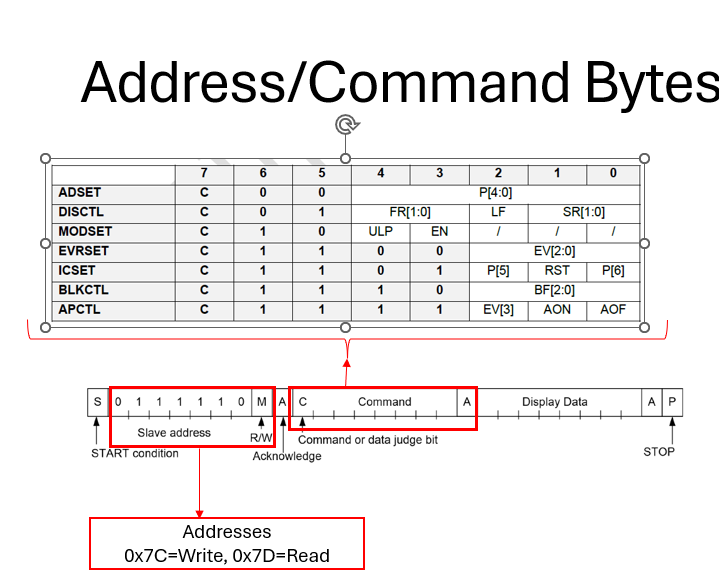请注意,本文内容源自机器翻译,可能存在语法或其它翻译错误,仅供参考。如需获取准确内容,请参阅链接中的英语原文或自行翻译。
器件型号:MSP430F6776A 工具/软件:
您好:
我不熟悉嵌入式系统、我尝试获得一个 LCD 板、其中 MSP 芯片作为主器件、LCD 作为从器件。
我使用了 Command 寄存器(位于文档中的第 6 页)来打开和关闭所有 LCD 段、但无法点亮特定的 LCD 段。
文档第 9 页显示了设置此项的示例、我的协议分析器上有数据、事务正在进行。
我的事务数据是 ICSET -> ADSET ->我要显示前 2 个段中的哪些位。 它与示例匹配、但不起作用。
什么是我的缺失?
谢谢。
LCD 板文档
工程
#include <msp430.h> #include <stdio.h> unsigned char TXData; unsigned char TXByteCtr; unsigned long TXDataBuffer[]={0x58,0x00,0xE8}; //These are sent in reverse order //0x58,0x00,0xC8,0xE8 int bulkTX = 0; unsigned long TXDataBufferSingle; void main(void) { WDTCTL = WDTPW | WDTHOLD; // Stop WDT // Setup P2.5 UCB0SCL, P2.6 UCB0SDA P4SEL0 |= BIT4 | BIT5; // Set P4.4,P4.5 to UCB1SCL, UCB1SDA //Setup LCD_PWR_EN P5DIR |= BIT0; P5OUT |= BIT0; //Turn on LCD power __delay_cycles(6000); //Delay for LCD power to startup, review timing // Setup eUSCI_B0 UCB1CTLW0 |= UCSWRST; // Enable SW reset UCB1CTLW0 |= UCMST | UCMODE_3 | UCSSEL_2; // I2C Master, use SMCLK UCB1BRW_L = 12; // fSCL = SMCLK/10 = ~95104.5kHz, /11 = 95kHz, /12= 87kHz UCB1BRW_H = 0; UCB1I2CSA = 0x3E; // Slave Address is 03Eh UCB1CTLW0 &= ~UCSWRST; // Clear SW reset, resume operation UCB1IE |= (UCTXIE0 | UCNACKIE); // Enable TX interrupt and NACK interrupt TXData = 0x7A; // Holds TX data, sending 0x7A for all pixels ON command to LCD bulkTX = 0; TXByteCtr = 1; TXDataBufferSingle = 0x79; while (UCB1CTLW0 & UCTXSTP) ; // Ensure stop condition got sent UCB1CTLW0 |= UCTR | UCTXSTT; // I2C TX, start condition __bis_SR_register(LPM0_bits | GIE); // Enter LPM0 w/ interrupts __no_operation(); // Remain in LPM0 until all data while (1) { bulkTX = 1; TXByteCtr = 3; // Load TX byte counter while (UCB1CTLW0 & UCTXSTP) ; // Ensure stop condition got sent UCB1CTLW0 |= UCTR | UCTXSTT; // I2C TX, start condition UCB1TXBUF = TXDataBuffer[2]; // first byte (0xE8) __bis_SR_register(LPM0_bits | GIE); // Enter LPM0 w/ interrupts __no_operation(); // Remain in LPM0 until all data // is TX'd //TXData++; // Increment data byte } } //------------------------------------------------------------------------------ // The USCIAB0_ISR is structured such that it can be used to transmit any // number of bytes by pre-loading TXByteCtr with the byte count. //------------------------------------------------------------------------------ // USCI_B0 interrupt service routine #if defined(__TI_COMPILER_VERSION__) || defined(__IAR_SYSTEMS_ICC__) #pragma vector = USCI_B1_VECTOR __interrupt void USCI_B1_ISR(void) #elif defined(__GNUC__) void __attribute__ ((interrupt(USCI_B1_VECTOR))) USCI_B1_ISR (void) #else #error Compiler not supported! #endif { switch (__even_in_range(UCB1IV, 30)) { case USCI_NONE: break; // No interrupts case USCI_I2C_UCALIFG: break; // ALIFG case USCI_I2C_UCNACKIFG: UCB1CTL1 |= UCTXSTP; // Generate I2C stop condition because communication failed break; // NACKIFG case USCI_I2C_UCSTTIFG: break; // STTIFG case USCI_I2C_UCSTPIFG: break; // STPIFG case USCI_I2C_UCRXIFG3: break; // RXIFG3 case USCI_I2C_UCTXIFG3: break; // TXIFG3 case USCI_I2C_UCRXIFG2: break; // RXIFG2 case USCI_I2C_UCTXIFG2: break; // TXIFG2 case USCI_I2C_UCRXIFG1: break; // RXIFG1 case USCI_I2C_UCTXIFG1: break; // TXIFG1 case USCI_I2C_UCRXIFG0: break; // RXIFG0 case USCI_I2C_UCTXIFG0: // TXIFG0 if(TXByteCtr && bulkTX == 1){ UCB1TXBUF = TXDataBuffer[(TXByteCtr-1)]; TXByteCtr--; } else if(TXByteCtr && bulkTX == 0){ UCB1TXBUF = TXDataBufferSingle; TXByteCtr--; } else{ UCB1IFG &= ~UCTXIFG; // Clear USCI_B0 TX int flag UCB1CTL1 |= UCTXSTP; // I2C stop condition UCB1CTL1 |= UCTXSTP; // Generate I2C stop condition because communication failed __delay_cycles(600000); //Delay between sending I2C messages __bic_SR_register_on_exit(LPM0_bits); // Exit LPM0 } /* //Code below worked well, added above to send multiple bytes if (TXByteCtr) // Check TX byte counter { UCB1TXBUF = TXData; // Load TX buffer TXByteCtr--; // Decrement TX byte counter } else { UCB1IFG &= ~UCTXIFG; // Clear USCI_B0 TX int flag UCB1CTL1 |= UCTXSTP; // I2C stop condition UCB1CTL1 |= UCTXSTP; // Generate I2C stop condition because communication failed __delay_cycles(600000); //Delay between sending I2C messages __bic_SR_register_on_exit(LPM0_bits); // Exit LPM0 } */ break; case USCI_I2C_UCBCNTIFG: break; // CNTIFG case USCI_I2C_UCCLTOIFG: break; // LTOIFG case USCI_I2C_UCBIT9IFG: break; // BIT9IFG default: break; } }


